Organic agriculture has become one of the most effective alternatives for combating soil degradation and climate instability. Its approach promotes a natural balance between production and sustainability, strengthening yields without compromising environmental resources.
Within this context, the work of Laird Dickinson, a grower from Wisconsin (USA) specializing in giant pumpkins and tomatoes, stands out. His experience demonstrates how constant observation, technical discipline, and the consistent use of organic products can completely transform crop productivity.

Background and Project Evolution
For over twenty years, Dickinson has viewed organic agriculture not only as a production method but also as a way of understanding the land. His experience has taught him that true agricultural success does not depend on the quantity of inputs applied, but on the balance between soil, water, and daily dedication.

His interest in giant pumpkins began unexpectedly:
“A friend gave me some ‘giant’ pumpkin seeds three years ago, and I planted two of them in a small portion of our garden. I was completely amazed watching these plants grow up to 24” per night. Once the pumpkins started to gain weight, I couldn’t believe it. I would run to the patch every morning with excitement to see how big they had gotten. I was hooked from that point.”
He began experimenting in a small section of his family garden, then gradually expanded his growing area. In his second year, he dedicated 3,600 sq ft to giant pumpkins, giving each plant 1,200 sq ft—enough space for three large plants with optimal room for root and vine development. Each plant is managed to produce only one pumpkin, allowing all energy to concentrate on a single fruit.

Over time, his approach evolved into a deeper understanding of soil health and nutrition.
“I began using Ferti-Organic products in spring 2024, having previously relied on salt-based synthetic fertilizers for my competitive gardens. I believed that growing giant fruits and vegetables required these ‘high-powered’ synthetic fertilizers. However, after an unsuccessful season where I spent a lot of money trying different synthetic products, I realized this approach wasn’t effective. I decided to switch to organic amendments and fertilizers to rebuild my soil, aiming to enhance both soil structure and biology.”
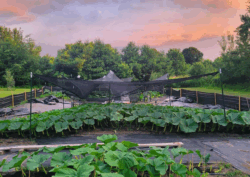
His experience in his family garden allowed him to apply that knowledge to competitive growing, fine-tuning his method to optimize fruit development and improve results each season.
“After researching, I found that Ferti-Organic offered all the organic fertilizers I required. When I saw tremendous improvements during the 2024 season, I committed fully for 2025… The plants’ health and the size of the fruits were truly amazing—I achieved my largest harvests ever in 2025 and won several competitions. Most importantly, my soil continues to become healthier, and I am confident we will see even better results in 2026!”

His consistency and dedication have made him a reference among growers of oversized fruits and vegetables. He has also applied these practices to giant tomatoes, achieving fruits of up to 7 pounds under fully organic management.
“Every year I learn something new. Observing how the soil responds and keeping records has helped me refine every detail.”

Environmental Conditions and Challenges
Wisconsin’s climate presents demanding conditions for giant crop cultivation. Short summers, heavy rains, and early frosts affect soil stability and root development. During one particularly challenging season, excessive moisture caused root rot and split a pumpkin nearing 700 pounds.
“That pumpkin would have reached 2,000 pounds, but the rain split it before its time. I was still able to keep another one that reached 800 pounds.”
This experience led him to reinforce drainage, implement preventive practices, and adjust application frequency to avoid water-related damage. For Laird, the conclusion was clear: soil health is the foundation of yield.
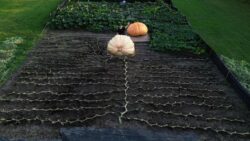
Organic Management in Practice
Laird’s system integrates soil analysis, balanced organic nutrition, microbial strengthening, and rigorous moisture and growth control.
1. Soil Preparation
Before each season, he evaluates soil fertility and applies the necessary amendments.
He uses plant-based compost tested for NPK values (8–12% organic matter) and winter rye cover crops to improve structure, aeration, and moisture retention.
2. Organic Nutrition
Throughout the season, he applies a blend of soluble seaweed extract, humic acids (70%) and Fulvic acids (90%). This is administered through irrigation every other day.
He complements with bonemeal, kelp meal, bloodmeal, and worm castings, adjusting doses based on plant development.
“This season, I used a blend of humic/fulvic acids and soluble seaweed extract every other day… The plants’ health and the size of the fruits were truly amazing.”
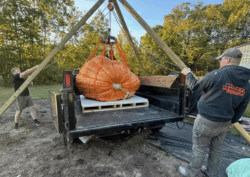
3. Biological Strengthening
He consistently incorporates mycorrhizal fungi, Bacillus, and Azospirillum, applying them to seeds, cover crops, and during vine burying. This interaction favors nutrient absorption and improves tolerance to high humidity conditions.
“These practices have resulted in huge, healthy root growth throughout the patch.”

4. Irrigation and Protection
His system combines drip irrigation with sprinklers. Early in the season, he protects young plants with hoop houses and heating cables. He also applies fungicides and pesticides weekly, always preventatively.
5. Growth Control and Fruit Management
Each vine is pruned daily to ensure only one pumpkin per plant.
“If you let all the side growth go, the plant will spread its energy and the main pumpkin won’t reach its potential.” (Paraphrased narrative based on his English answers)
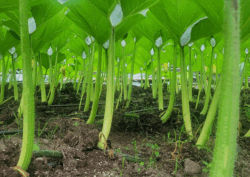
He also uses black tarps early in the season for weed control and trains vines for efficient manual weeding.
Outstanding Achievements
Laird’s organic management has enabled extraordinary harvests. His pumpkins have exceeded 1,900 pounds, reaching a personal record of 1,940 pounds in the most recent season. That pumpkin was presented at the Nekoosa Giant Pumpkin Festival, where it weighed 10% more than estimated and earned second place overall as well as second place in the esthetics category; the fruit was purchased by a professional carver to be carved and displayed near Chicago. Together, his two primary pumpkins surpassed 4,100 pounds, and Laird maintains the goal of reaching 6,000 pounds in a single season — a feat achieved by only a few growers.
His tomato crop reached 30 pounds across five fruits, with single tomatoes reaching 7 pounds, thanks to the consistent use of seaweed extract, humic and fulvic acids, and amino acids.
“With organic fertilizers, the soil gets better every year. With synthetics, it’s the opposite.”
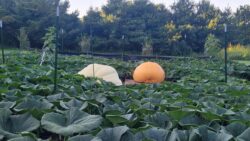
The use of our products has strengthened his root systems, supported moisture management, and enhanced productivity even under challenging conditions.
Beyond the weight achieved, their experience confirms that organic agriculture can be productive, competitive and sustainable when applied consistently and with technical expertise.
“I learned that if you take care of the soil, it will take care of the rest.”
This certainty drives his work and shapes his vision for the coming seasons. Laird continues refining his practices with the discipline that has characterized him for years—determined to exceed his own results and continue improving the quality of his organic production.

We invite you to follow @growing_giants_with_laird and discover every stage of the growth of his impressive giant pumpkins and tomatoes—an example of the potential you can also achieve in your own crops with our products. Learn more about our solutions and contact us today.

